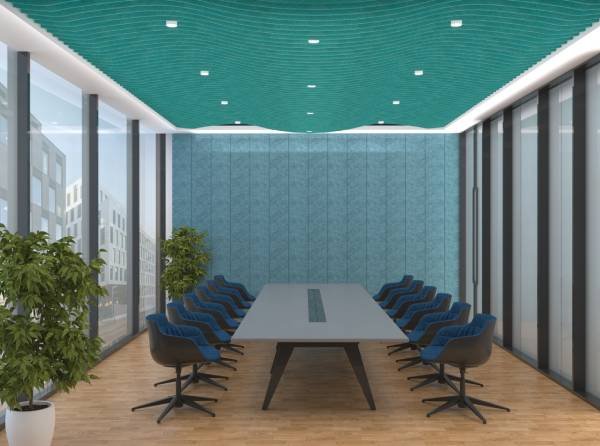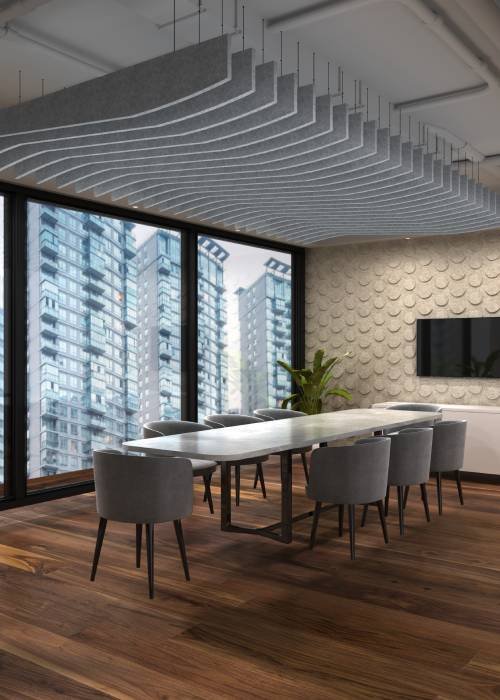Acoustic boards help lessen undesirable reflected sound in any room...
Having false ceiling designs for your interior spaces is the common trend in the current scenario. Thanks to the visually-aesthetic feel which such ceilings provide for letting the inhabitants enhance the look and living conditions of their offices or residential areas. Additionally, such ceilings help conceal wires, ducts, cables, and the hardware of your light fittings , air conditioning, sound systems, alarms among other things. It also helps you plan for ambient lighting, which is essential to create a mood in any space and is very popular nowadays.
So, before getting into details, let’s first know – what is a false ceiling? And why is it required?


These are designed to add beauty and elegance to the architecture. These are commonly constructed at a minimum distance of 8 to 8.5 inches from the original ceiling. They can be erected with different designs, patterns, and shapes irrespective of the size or dimensions of the property.
The ceiling design can also be customized as per the needs and preferences. And there are innumerable office false ceiling designs that you can choose from for your specific corporate.
False ceilings are meant to provide good aesthetics, which means it provides pleasure to the senses due to its incredible designs and unique formations.
Sound Absorption: A false ceiling is known to provide good acoustic performance where the required sounds can be ameliorated and at the same time some undesired sounds can be reduced.
Space provision: It also provides space for pipes, ducts, and electric wires.
Reduced Energy consumption: It helps to reflect and diffuse the light to a larger area. Thus, reducing the need for unnecessary artificial lighting and therefore helping in lowering energy consumption.
Types of false ceilings based on the material used!
Some leading types of false ceilings include:
1. Glass false ceilings.
2. Fiber false ceilings.
3. Wood false ceilings.
4. Plaster of Paris false ceilings.
5. Gypsum false ceilings.
POP stands for Plaster of Paris. It’s primarily gypsum without any water content. It is very commonly used in a variety of commercial and residential roofing. It is a good insulator of cold and heat. It becomes very hard when water is added to it and is therefore used as good ceiling material. It is very durable and also maintenance-free.
Furthermore, make sure to get the ceiling fan rod installed on the ceiling slab prior to the false ceiling construction. Whether it’s gypsum false ceiling, wooden ceiling, pvc tile ceiling, or any other lightweight ceilings, install the fan rod first. Moreover, when it’s the matter of heavy items like swings, always remember to install a sturdy hook in the slab before making the false ceiling allowing it to hold the weight of the swing.
Gypsum is a popular material used for false ceilings. It is lightweight, fire-resistant, and has good thermal and sound insulation properties. It is available in different hues like brown, white, red, yellow, and grey. It is also available as a colorless or clear material. They can be painted and laminated to give them a more pleasing look and appearance. Besides, it comes with different shapes and textures like curved, plain, coffered, and more. The gypsum board false ceiling price is quite moderate, you can use this type of false ceiling for your home or office.
They are easy to install and soothing to the eyes. They are durable but may be susceptible to termite infestations and warping. They can also be painted in different colors and textures. As wood is costly, wooden false ceilings can be quite an expensive choice. Nevertheless, if budget is not your problem you can easily go for it.
Fiber false ceilings are widely used for their soundproofing or acoustic performance, these have good sound and heat insulation features, which is why they are highly preferred in commercial places. These ceilings involve the use of mineral fiber ceiling tiles. These ceilings involve a medley of natural and synthetic materials such as tars, wood, stone, vegetable fiber, etc.
The fiber false ceilings are therefore very tough, durable, and resistant to fire as well. These are widely used in showrooms, shopping malls, corporates, and offices.
They are gaining popularity in commercial applications as they are quite inexpensive, easy to install, and proffers many functional benefits. These are not used for residential properties as these lack aesthetic appeal and are not so fancy.
Glass ceilings give the most aesthetic looks and therefore these are widely used in libraries, jewellery stores, restaurants, etc. These look gorgeous and provides a sense of closeness to the outside environment, relaxes the mind, and is soothing to the eyes.
These can be painted, laminated, or patterned using different hues and designs. Not only this, but it also acts as a good heat insulator.
Thus, there are different types of false ceilings, that come up with different unique patterns and types.
These not only enhance the beauty of the home or office but also adds an aesthetic element to the property.
We hope that the information shared above has provided a much clear understanding to you about what false ceilings are, their types, and how do they vary from each other.
Contact us and get more details about false ceilings – why are they widely used in commercial spaces, the benefits of false ceilings, and more queries related to different products like partitions, insulations, and more! Call us at 9625332290 or visit us at https://unidusindia.com/ to know more!
Acoustic boards help lessen undesirable reflected sound in any room...
Acoustic boards help lessen undesirable reflected sound in any room...
Open spaces have been known as the trending layout for...
WhatsApp us